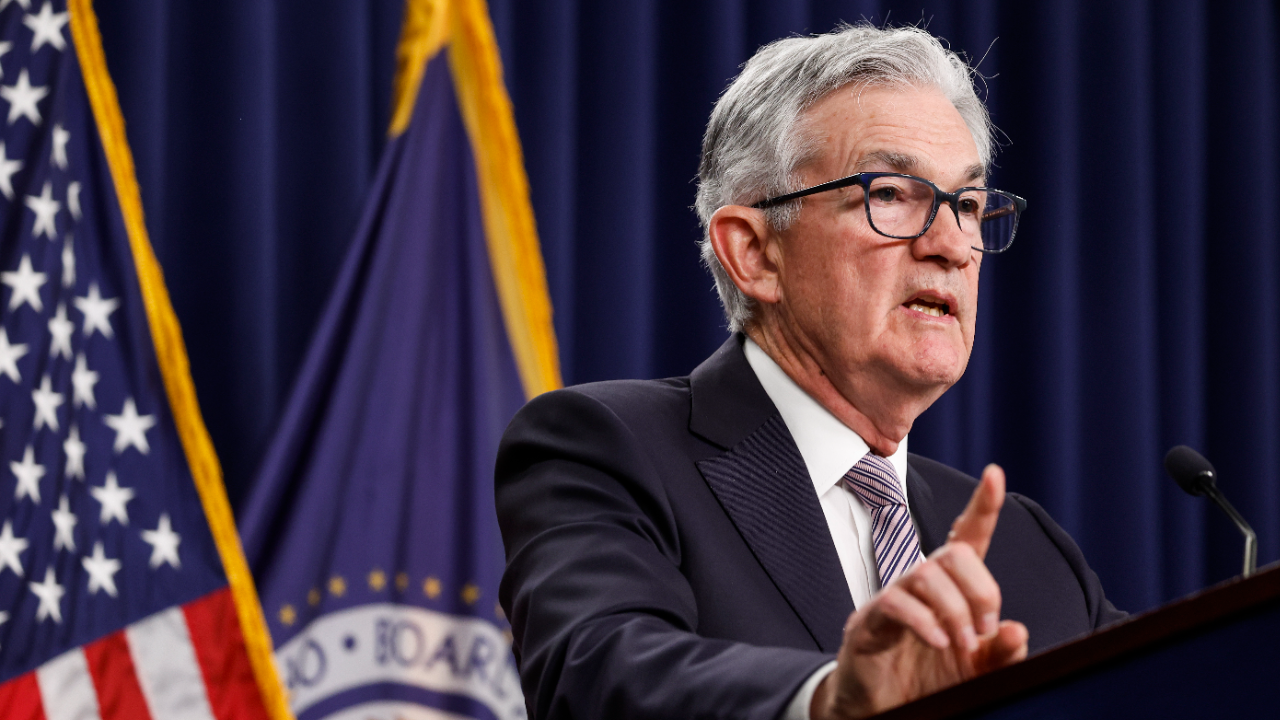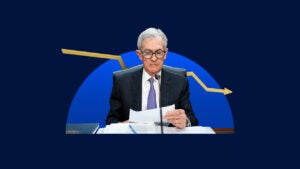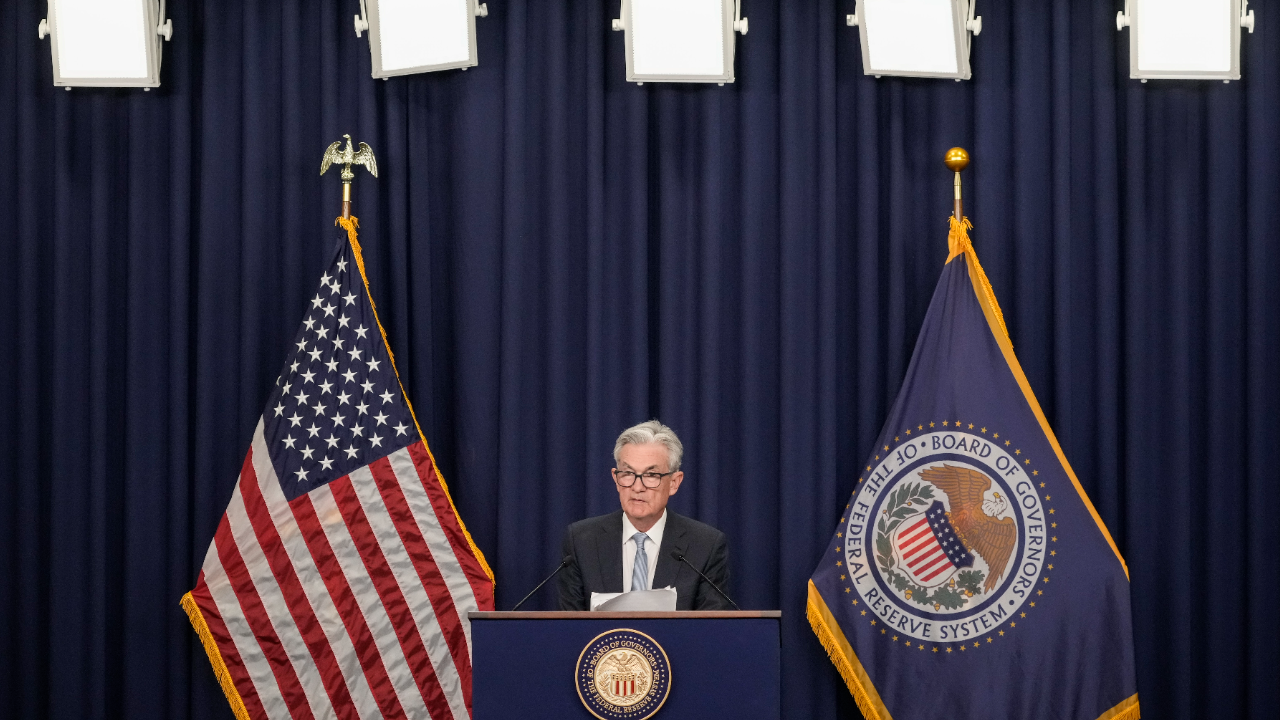Fed holds off on interest rate hike but sees more increases coming this year

Fifteen months into a historic inflation fight, the Federal Reserve decided not to raise interest rates at its June meeting but penciled in two more rate increases this year — showing its rapid pace of increases are not yet over.
Policymakers on the Federal Open Market Committee (FOMC) kept their key borrowing benchmark at its current target range of 5-5.25 percent. The move gives consumers time to form a game plan with their finances for the first time since March 2022, but a pause doesn’t offer much relief. The Fed’s borrowing benchmark hasn’t been this high since 2007.
Fed officials also revealed a bias to raise rates even higher. The median forecast for the fed funds rate showed 50 basis points worth of additional rate hikes, moves it could either approve at once with one more historic rate hike or twice with two quarter-point moves. If both come to fruition, it means the Fed could take interest rates to their highest since 2001 by the time its inflation fight eventually comes to an end.
“The question of speed is a separate question from that of level,” Chair Jerome Powell said during the Fed’s post-meeting press conference. He stopped short of calling the move a “skip,” a term that suggests a rate hike is imminent for the next meeting in July. “It may make sense for rates to move higher, but at a more moderate pace.”
The Fed has been sprinting to catch up with inflation, raising interest rates by 500 basis points in just over a year’s time. Consumer interest rates across the economy have joined the race. Home equity lines of credit are the highest since 2001, mortgage rates are pushing 7 percent and car loans haven’t been this high for 13 years. Credit card rates, meanwhile, have hit a new all-time record high for 12 straight weeks.
The only major boon for consumers comes on the savings front. Yields at online banks are now hitting 5 percent annual percentage yield (APY), and many now eclipse the overall inflation rate. Better deals translate to more earnings on the cash consumers keep sitting on the sidelines, helping them pad up their emergency funds and take other crucial financial steps.
Inflation has also now been cut in half from its peak, hitting a 4 percent annual rate in May after soaring as high as 9.1 percent in the summer of 2022. But the Fed’s quest to defeat those price pressures is in no way complete. Prices are still twice as high as the Fed’s 2 percent inflation goal, and when cutting out cooling food and energy prices, inflation is rising at a much more rapid pace of 5.3 percent year-over-year.
That tough economic environment is keeping the Fed on guard to raise interest rates again, even if it risks weakening the economy or exacerbating a credit crunch after the recent banking crisis in March.
“Further rate hikes seem very likely, if not a near certainty,” says Greg McBride, CFA, Bankrate chief financial analyst. “Between a robust job market and the core rate of inflation more than double the 2 percent target, one thing is clear: The Fed is nowhere close to cutting interest rates.”
The Fed’s rate pause: What it means for you
Savers
The Fed might not have raised rates, but the story hasn’t changed: Rates may be nearing their peak, but it hasn’t been this rewarding to save for more than a decade.
The average APY on a savings yield has risen from 0.06 percent in May 2022 to 0.25 percent as of June 7, the highest since 2008, according to national Bankrate data. But savers can get an offer around 20 times higher than that if they keep their cash at an online bank. Savers who bank with big players such as Chase or Bank of America may see an even bigger lift: a yield that’s 400-500 times higher.
Another key win is already unfolding: Cooling inflation. To be sure, prices are still making it harder to afford the items Americans both want and need, but consumers are now in a better position to safeguard their cash’s purchasing power as it sits on the sidelines. That’s because many high-yield savings accounts on the market are now offering yields higher than the overall rate of inflation.
But while higher interest rates are the clear perk to saving right now, they’re not necessarily the reason consumers should stash cash away. Saving, especially for emergencies, is as important as ever. A Bankrate survey of economists from April put the odds of a recession in 2023 at 64 percent — suggesting it’s more likely than not as the Fed quickly slams on the brakes of the world’s largest economy. Make sure the savings account you select is liquid and accessible, so you can turn to the cash if you need it in the event of an unexpected expense.
And if you’ve already established an emergency fund, consider locking in a certificate of deposit (CD). Yields on longer-term CDs could begin to drift lower as soon as the Fed signals that rates are on hold, suggesting now may be the time to lock in today’s higher rates before they slip away from you.
Borrowers
Another reason why building up an emergency fund is crucial: The price of having to pay for an unexpected expense with a credit card is higher than ever. The national average credit card annual percentage rate (APR) notched a new record high of 20.44 percent on June 7, up from 16.34 percent before the Fed started hiking rates, according to Bankrate data.
“Even with a pause, which doesn’t appear like it is going to last very long, interest rates are still the highest in years,” McBride says. “Paying down high-cost, variable-rate debt is an urgent priority for households.”
The Fed skipping a rate hike may give borrowers a chance to shop around and craft their debt-payoff game plan before another potential rate increase. Each rate hike from the Fed translates to higher borrowing costs for almost every type of loan, from car loans and credit cards to variable-rate mortgages and personal loans.
If you’re trying to chip away at your high-cost credit card debt, consider utilizing a balance transfer card with a 0 percent or low-rate APY introductory offer.
But borrowing costs could even keep edging up, even amid a Fed pause. It often takes months, if not years, for the full effects of a rate hike to trickle through the economy. Lenders have been adjusting to a rapidly changing environment, meaning some of the Fed’s past rate hikes could still be in the pipeline. Even so, banks could tighten their belts on lending after three major regional bank failures stung the financial system earlier this year, another force leading to higher interest rates that could also make it harder to qualify for a loan.
A rate pause does nothing to change just how high borrowing costs have soared — and how likely they are to stay that way.
Homebuyers
After leveling off since the fall of 2022, mortgage rates are back on the ascent again — posing trouble for would-be homebuyers who are also now dealing with a renewed pick up in home prices, according to S&P CoreLogic’s latest Case-Shiller price index.
The average 30-year fixed-rate mortgage hit 6.91 percent APR in early June, the highest since November 2022, according to Bankrate rate data. To be sure, the key home-financing loan could reverse some of those gains, especially with inflation slowing. But rates are unlikely to fall as low as they were in the aftermath of the pandemic anytime soon.
A $340,000 30-year mortgage would’ve cost $1,507 in principal and interest back in January 2022, before the Fed started raising rates, according to Bankrate’s mortgage calculator. That monthly payment would now be $2,192 — a 45 percent jump — if a homebuyer locked in a 30-year fixed-rate mortgage at 6.69 percent, which has been the average over the past eight weeks.
To be sure, the median sale price of a U.S. home has cooled, albeit gradually, sinking about 9 percent from its high in the fourth quarter of 2022 to $436,800 in the first quarter of 2023, Census Bureau data shows.
The housing market is also cooling, with existing-home sales activity in April declining 3.4 percent month-over-month and 23.2 percent year-over-year, according to National Association of Realtors (NAR) data.
But keeping prices elevated is a continued housing shortage, with the National Association of Realtors estimating the market only has a 2.9-month supply of inventory. Typically, a balanced market has around a six-month supply.
It all suggests homebuyers are going to keep facing a new, tougher era for the housing market — one with higher rates, higher costs and less supply.
Investors
Investors appear to be looking past the most hawkish Fed in decades, with the S&P 500 up almost 15 percent so far in 2023. Cooling inflation and a resolution to a debt ceiling debacle are helping make markets even more confident.
That doesn’t mean the tone could change — and quickly. The U.S. economy is still catching up to the 500 basis points worth of rate hikes, and for now, only the rate-sensitive housing sector seems to be bearing the brunt of the burden. Any sign of trouble in the job market, for instance, could make the threat of a recession even more imminent.
Fed officials have also been quick to correct markets’ expectations that they’re not likely to cut rates anytime soon. So far, that’s fallen on deaf ears, with investors still expecting a modest, quarter-point rate cut by the Fed’s meeting in December, according to CME Group’s FedWatch tool. If investors end up being proven wrong, it could make for a bumpy ride in the stock market.
But day-to-day gyrations shouldn’t matter for the long-term investor. Stay the course with a diversified portfolio of investments, and tune out the bogeyman of the day. Remember: The Fed’s ultimate goal in slowing the economy now is preventing more pain from happening down the road, especially if it were to pull back on higher rates too soon and risk high inflation becoming entrenched.
What is the Fed’s next move?
A resilient economy has thrown cold water on economists’ forecasts — as well as the Fed’s.
The job market continues to deliver the biggest surprises. Employers over the past 12 months have added more than 4 million jobs, a pace two times as fast as what prevailed before the pandemic. Unemployment has edged up but remains near historically low levels. Layoffs, meanwhile, aren’t spreading throughout the entire job market, and applications for new unemployment benefits have remained relatively stable. Job openings are still outnumbering the unemployed — making it easier for individuals who do lose their jobs to find new positions fast.
Fed officials notably marked down their forecasts for where unemployment will go, not just in 2023 but also for two years from now. Joblessness is seen hitting 4.1 percent in 2023 and peaking at 4.5 percent in 2024 through at least 2025. That’s after forecasts showed joblessness hitting 4.5 percent this year and bouncing up to 4.6 percent over the next two.
“The labor market, I think, has surprised many if not all analysts over the last couple of years with its extraordinary resilience,” Powell said. “It really is the engine, it seems, that’s driving the economy.”
The strength in the job market led policymakers to also mark up their growth forecasts, with officials now expecting the economy to grow 1 percent in 2023 after a more tepid 0.4 percent projection just last March.
The Fed’s inflation fight continues
That might, however, make price pressures harder to stomp out. Core prices are seen rising 3.9 percent in the year, up from 3.6 percent from the last time officials updated those forecasts.
“You’re not seeing a lot of progress,” Powell says, referring to core inflation. “We want to see it moving down decisively.”
Taken together, those economic forecasts forged the way for a dovish decision that still had a hawkish outcome. All but two policymakers see the Fed raising rates higher from here — with four officials projecting one more rate hike worth a quarter-point, nine policymakers expecting two rate hikes, two more expecting three rate hikes and one expecting four.
Powell noted the Fed is treating July as a “live” meeting, hinting that Fed officials could decide to raise interest rates again in six weeks. Yet, the Fed decided not to raise rates in June to ultimately give it more time to assess the evolving outlook, including how much past rate hikes will get the job done. Just one more inflation and employment report is slated to be released before the Fed’s next meeting.
A pause in June would give officials “a full quarter” of data that they can draw on by July, Powell added, rather than just the typical six weeks officials have been basing their past 10 decisions on.
“Speed was very important last year,” Powell said. “As we get closer and closer to the destination, it’s common sense to go a little slower.”
What to think about the Fed’s ‘hawkish pause’
Experts, however, note it does create communication challenges. If Powell & Co. are worried about inflation as much as they say they are, consumers and investors may start to wonder: Why not raise rates now?
Bill Adams, chief economist at Comerica Bank, noted a disconnect between the language of both the projections and the policy statement. While noting the possibility for two more rate hikes, Fed officials didn’t put language calling for “additional policy firming” back in the statement.
“FOMC members see a high degree of uncertainty about how much they should tighten rates going forward,” Adams says. “The language today was hawkish, but the action was dovish, and if the Fed really wanted to signal more hawkishness, they would’ve raised interest rates at today’s decision.”
Even if the Fed doesn’t end up following through, signaling that rate hikes are over could end up working against the Fed. Monetary policy primarily cools inflation by influencing financial markets.
Investors, however, have to first expect more tightening, and markets didn’t appear to take the Fed’s message seriously. The 2-year Treasury yield remained largely unchanged throughout the day at 4.7 percent, despite Powell signaling that more rate hikes are likely.
“The risks of overdoing it and underdoing it are getting closer to being in balance,” Powell said. “I still think, and my colleagues agree, that the risks of inflation are to the upside still.”






